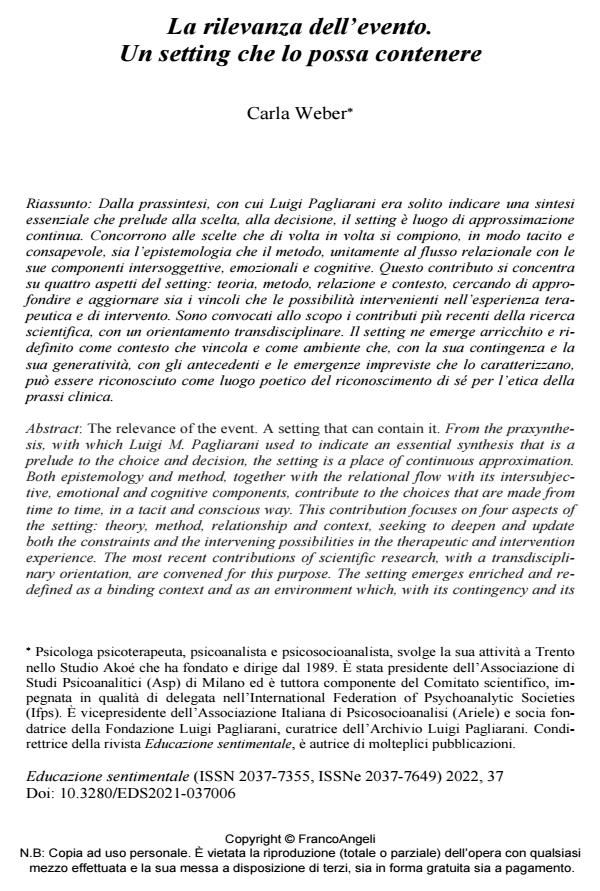Un setting che lo possa contenere
Journal title EDUCAZIONE SENTIMENTALE
Author/s Carla Weber
Publishing Year 2022 Issue 2022/37 Language Italian
Pages 7 P. 76-82 File size 164 KB
DOI 10.3280/EDS2022-037006
DOI is like a bar code for intellectual property: to have more infomation
click here
Below, you can see the article first page
If you want to buy this article in PDF format, you can do it, following the instructions to buy download credits

FrancoAngeli is member of Publishers International Linking Association, Inc (PILA), a not-for-profit association which run the CrossRef service enabling links to and from online scholarly content.
The relevance of the event. A setting that can contain it. From the praxynthesis, with which Luigi M. Pagliarani used to indicate an essential synthesis that is a prelude to the choice and decision, the setting is a place of continuous approxi-mation. Both epistemology and method, together with the relational flow with its intersubjective, emotional and cognitive components, contribute to the choices that are made from time to time, in a tacit and conscious way. This contribution focuses on four aspects of the setting: theory, method, relationship and context, seeking to deepen and update both the constraints and the intervening possibili-ties in the therapeutic and intervention experience. The most recent contributions of scientific research, with a transdisciplinary orientation, are convened for this purpose. The setting emerges enriched and redefined as a binding context and as an environment which, with its contingency and its generativity, with the ante-cedents and unforeseen emergencies that characterize it, can be recognized as a poetic place of self-recognition for the ethics of clinical practice.
Keywords: setting, praxynthesis, theory, method, relationship, context, intersubjectivity, empathy, neuroplasticity
- Greenberg J.R., Mitchell S.A. (1983). Le relazioni oggettuali nella teoria psicoanalitica. Bologna: Il Mulino, 1986
- Lotman J.M. (1985). La semiosfera. L’asimmetria e il dialogo nelle strutture pensanti. Milano: La nave di Teseo, 2022.
- Morin E. (1972). Teorie dell’evento. Milano: Bompiani.
- Pagliarani L. (1990). Introduzione. Glossario di psicoterapia progettuale. Milano: Guerini e Associati.
- Stern D. (1985) Il mondo interpersonale del bambino. Torino: Bollati Boringhieri, 1987.
- Strevens M. (2020). La macchina della conoscenza. Come l’irrazionalità ha creato la scienza moderna. Torino: Einaudi, 2021.
- Bateson G. (1979). Mente e natura. Milano: Adelphi, 1984.
- Bateson G. (1972). Verso un’ecologia della mente. Milano: Adelphi, 1977..
- Damasio A. (2021). Sentire e conoscere. Milano: Adelphi, 2022.
- Vernadskij V.I. (1926-1945). La biosfera e la noosfera. Palermo: Sellerio, 1999.
- Weber C. (2016). Poesia e ragion poetica come vie per l’espressione e l’accesso del mondo interno. Setting. Quaderni dell’Associazione di Studi Psicoanalitici, 41-42, 2016.
Carla Weber, Un setting che lo possa contenere in "EDUCAZIONE SENTIMENTALE" 37/2022, pp 76-82, DOI: 10.3280/EDS2022-037006